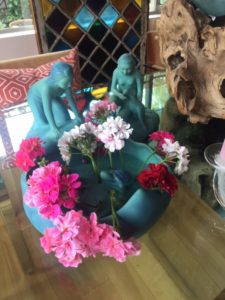 I confess that I LOVE this pottery piece. My partner John’s father collected this maker, Van Briggle Studios, founded by the husband and wife team, Aratus and Anne Van Briggle.
I confess that I LOVE this pottery piece. My partner John’s father collected this maker, Van Briggle Studios, founded by the husband and wife team, Aratus and Anne Van Briggle.
This pottery played instrumental in getting me started in collecting “Art” ceramics. My grandmother Ruth Sophia collected a piece of Van Briggle on her honeymoon with my grandfather Frank. Intrepid in the 1920’s they traveled from St Louis to Colorado in Frank’s Model T. My grandmother used to say she borrowed a pair of men’s trousers for the long ride in case they broke down, which they did, many times.
Thus, the Van Briggle name and a visit by my grandparents to the Van Briggle studio in Colorado Springs remained a family story for years.
The piece pictured is finished in the hallmark satin glaze, called Turquoise Ming. My partner John owns a large bowl with a draped female nude in a glaze called Persian Rose. My favorite theme in the oeuvre of Van Briggle pots are the “Maiden” series, mainly nude figures of Hopi maidens, created in a flowing Art Nouveau style. Usually these maiden figures are either draped around a shell, a large calla lily, a naturalistic jug or flower form.
The history of the studio in Colorado Springs sounds as fascinating as its founders. The husband and wife potters Anne and Artus founded the studio as a couple, an unmarried couple. They traveled from their positions at the famous Rookwood Pottery of Cincinnati to settle as artisans in Colorado in 1901. They usually designed and built their wares together. The greatest of all their pieces bear a “AA” mark on the bottom for Artus and Anne, significantly, for lovers, joined together at the tops of both “A’s.”
The Van Briggle Studio
Artus and Anne, and other talented potters such as friend Fred Wills, hand threw pots on an outdoor potter’s wheel. This era became known for the “Craftsman,” and the handmade aesthetic. The Van Briggle salesroom, the masterpiece of Craftsman design my grandmother visited, contained a huge arched fireplace tiled in the company tiles, and a line of their wonderful colored vases on the monumental hearth. I wish I’d seen my grandmother pick out the bowl passed down in my family.
Artus possessed a penchant for nudes, and broke new ground with his designs featuring male nudes. Think about this in 1901. Artus’ most famous male nude, “Despondency,” featured a gorgeous male nude in the Art Nouveau style clinging to the side of a jewel toned ceramic vase.
This vase won first prize at a show in Paris, the headquarters for anything Art Nouveau. For an American to win a prize with a piece in the Nouveau style in PARIS was a big deal. So big, that the Louvre paid $3,000 for this piece. This design became so successful that Artus designed a female counterpart, called the “Lorelei” vase.
Aratus and Anne married in 1902
Engineering-minded Artus created molds for most of the pieces Anne and he designed together. This proved invaluable when he died young in 1904, leaving Anne with the molds, a broken heart, and a business to run. Anne turned the Van Briggle Pottery studio into a more popular direction, producing smaller, less risqué material, such as Art Nouveau style vases with floral motifs, and small animal figures. Look for these in that matte glaze of turquoise, maroon, green, pale orange, lavender, and pink, using slight gradations in color, but only ONE matte color per piece. The animal figurines proved quite popular, especially animals designed as bookends. What better than a pair of elephants?
Not only producing decorative vases, Van Briggle produced tiles for rooftops, and large urns for hotels like the Pueblo, out “West.”
Right before WW II, Van Briggle Studios took another design turn, and marketed these wonderful Maiden figural vases and flower boats pictured here. The Hopi maidens were accompanied in production by Hopi braves, usually made in the forms of wall plaques, while the maidens were designed (nude) as part of a vase or bowl.
During the war years, planters became popular, and you will find them in shell shapes. A few lucky collectors own pairs of lamps in the turquoise Ming shade, with custom designed lampshades with butterflies in the translucent paper.
The Maiden bowls, with their handmade flower frogs to hold the blossoms, of which you see two, are worth $600-700 today.
Pingback: Valuables That Barely Escaped the Garbage - Elizabeth Appraisals